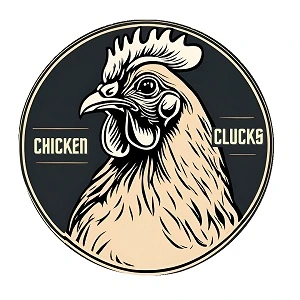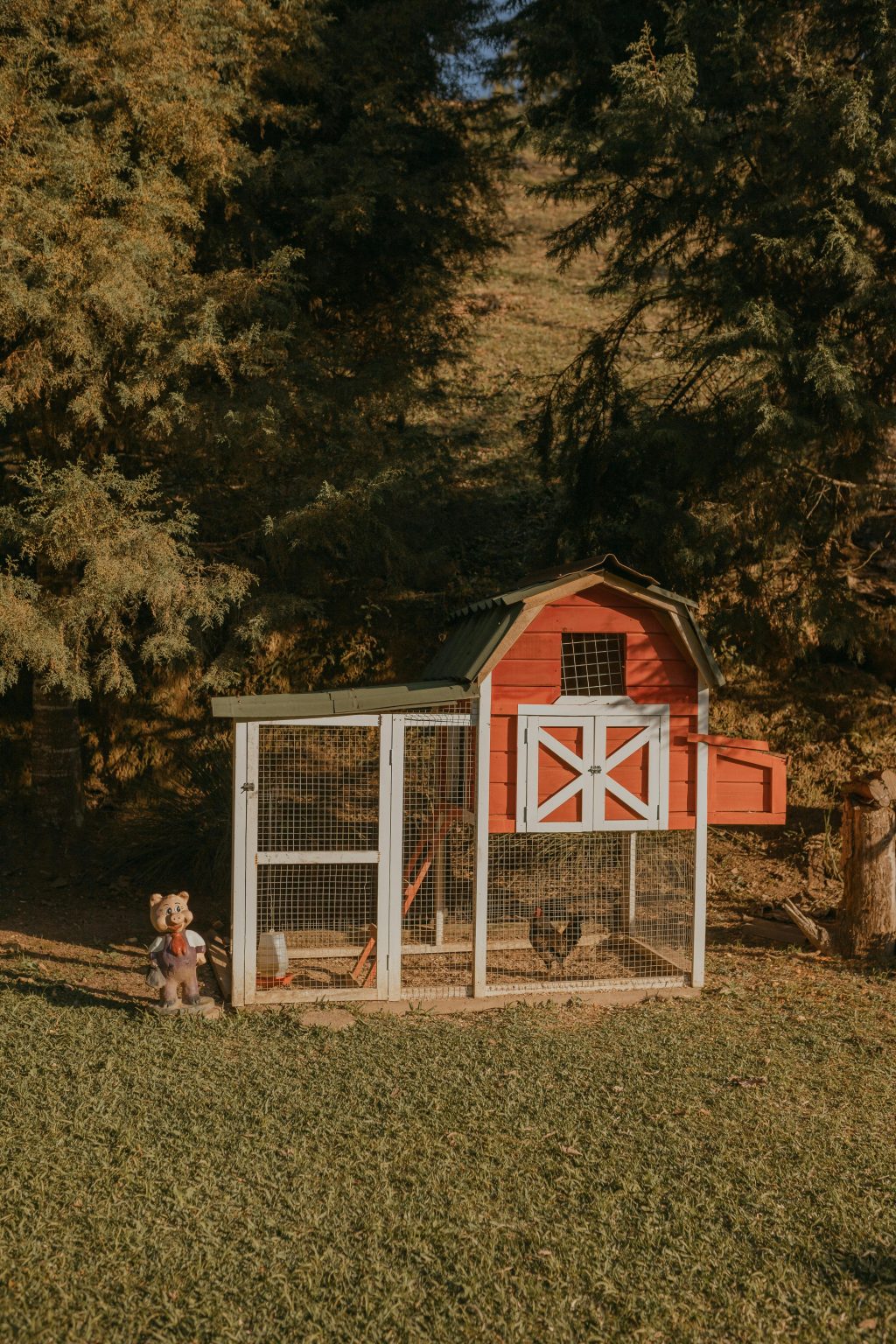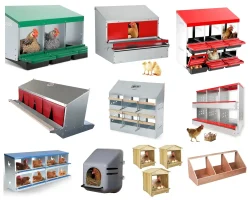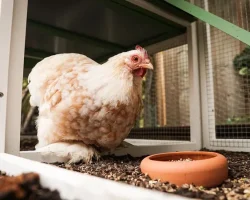Choosing the right chicken coop is one of the first (and most important) decisions you’ll face when you start raising backyard chickens. But with so many options available, where do you even begin? Wood, plastic, metal… Big, small, walk-in… Predator-proof, water-proof, escape-proof… It’s a clucking chaos!
This guide will walk you through everything you need to consider, so you can choose the best coop to keep your hens happy.
The Age-Old Question: Build or Buy Your Chicken Coop?
Hold your hens! Before we dive into the nitty-gritty of coop features, there’s another crucial decision you have to make first.
Do you want to build your own chicken coop or buy a pre-made one?
Let’s weigh the pros and cons of each option, so you can decide which would be easier for you: grabbing your hammer, or your credit card? Heads up: you’ll likely need to use both! Even DIY chicken coops come with the cost of materials, while pre-made chicken coops often still require some assembly once they arrive.
Building It Yourself
Building your own coop gives you ultimate creative control. You can customize every aspect to perfectly match your flock’s needs, your aesthetic preferences, backyard space… And most importantly, your budget.
Savvy shoppers can source affordable materials and repurpose old items to create a coop that’s both stylish and economical. Got some leftover fencing from a previous project? Perfect for the run. That old dresser in the attic? Transform it into a chic nesting box.
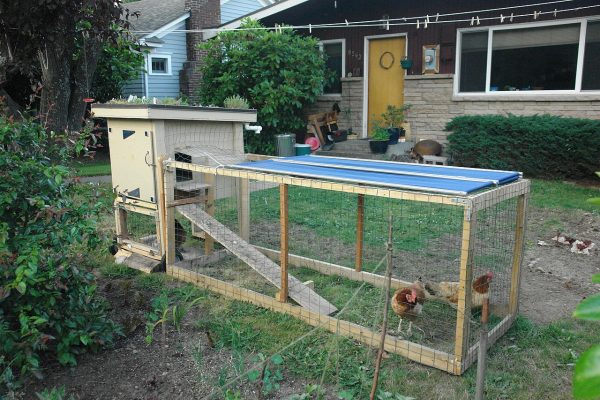
With a bit of creativity, you can turn it into a fun project for your whole family. And then every time you walk by it, you’ll feel a sense of accomplishment and pride.
Remember, DIY doesn’t mean starting with a blank slate though. Plenty of free chicken coop plans are available online. Or if you’re looking for something more sophisticated, you can even find paid ones with more elaborate designs.
Buying a Coop
Now, if you have two left hands or prefer the easy solution, a pre-made chicken coop is the stress-free way to go.
The choices here are endless. You can go for the:
- Classic Wooden Coop: Timeless and charming, these offer a traditional look and great insulation. You can find options in cedar, pine, or even recycled wood for a more eco-friendly touch.
- Modern Plastic Coop: Prefer something low-maintenance? Plastic coops are durable, super easy to clean, and often come in vibrant colors to brighten up your backyard.
- Metal Coop: If you search for metal coops, you will often get search results with metal runs (not coops). These sturdy structures are tough enough to keep even the most persistent predators out, like raccoons. Just keep in mind you will still need a coop to go with that metal run.
- Chicken Tractor: Chicken tractors are mobile coops that you can easily move around your yard to give your flock fresh grass and a new view everyday.
- Smart Chicken Coop: The newest kind of chicken coop that provides efficiency and automation. Depending on the type, it can offer an automatic door, camera, solar panel and control by an app on your phone.
Many of these pre-built coops use high-quality materials and expert construction techniques. They’re designed with your chickens’ well-being in mind, ensuring proper ventilation, predator protection, and the comfort of your flock.
Plus, reputable coop manufacturers like Omlet often offer warranties and excellent customer support, so you’re not alone if any issues arise.
Investing in a high-quality chicken coop is the ultimate “set it and forget it” solution, without the headaches of trial and error. Plus, a productive flock can help you save on your grocery bill by providing a steady supply of fresh, home-laid eggs!
Features of Good Chicken Housing
Chickens have specific needs and preferences when it comes to their living quarters. Neglecting these can lead to stressed chickens, poor egg production, and health issues from bad ventilation or unsafe designs. Worse yet, a poorly secured coop can invite predators or lead to escaping chickens, turning your backyard dream into a nightmare.
A bit of thoughtful planning upfront will save both you and your chickens from unpleasant surprises. So before you get caught up in the excitement of coop shopping or construction, take a moment to consider these essential features.
Providing a Chicken Run
Your chickens will need outdoor space to stretch their legs, scratch around, and soak up some sunshine. A chicken run is a fenced-in area attached to the coop, providing a safe and enclosed space for your flock to roam.
Many pre-made coops include a built-in run, but not all. If yours doesn’t, you’ll need to either build one or purchase a separate run.
Like coops, you can also find free DIY plans for chicken runs.
Securing Your Coop and Run
Raccoons, foxes, weasels, and even neighborhood cats are a threat to your chickens. Proper security measures are crucial to protecting your flock from these predators, especially at night when they’re most active.

- Sturdy Construction: Choose strong materials, like thick wood, reinforced corners, and sturdy hardware, to protect your coop against attempted break-ins.
- Predator-Proof Wire: Use 1/2″ or 1/4″ hardware cloth instead of chicken wire, as it’s more resistant to chewing. Bury the hardware cloth at least 12 inches (0.3 meters) deep around the perimeter of the run to prevent predators from digging under.
- Secure Latches: Ensure all doors and access points have secure latches that predators can’t easily open. Avoid simple latches or hooks that can be easily nudged or lifted. Use slide bolts or hasps with padlocks.
- Elevated Design: Raise the coop off the ground to prevent burrowing. Consider using concrete blocks or pressure-treated lumber to create a solid foundation. For the run, you can also use raised garden beds to create a secure perimeter.
- Roofing: Use roofing material like corrugated metal or polycarbonate panels for an extra layer of protection from aerial predators like hawks and owls. For a more budget-friendly option, you can also use shade cloth.
Weather-Proofing
Chickens are surprisingly hardy, but they still need protection from the elements. A good coop should keep your flock comfortable in all weather conditions.
For summers:
- Ventilation: Include vents high and low on the coop walls to allow for air circulation and prevent moisture buildup. You can also add windows with adjustable openings for cross-ventilation.
- Shady Spots: Plant trees or shrubs near the coop and run, or create shade with tarps, shade cloth, or even strategically placed umbrellas.
- Cool Flooring: Avoid flooring materials like concrete that absorb and radiate heat. Instead, use dirt, sand, or wood shavings.
For winters:
- Waterproof Roofing: A sloped roof with an overhang will prevent leaks and keep the coop dry.
- Insulation: Use rigid foam insulation board on the walls and ceiling, and consider adding a layer of weather stripping around doors and windows.
- Draft Protection: While ventilation is important, you also want to avoid drafts in the winter. Make sure any openings are properly sealed. Consider adding curtains or blankets over vents on particularly cold nights.
Keeping Your Chickens Comfortable
Chickens need enough space to move around, roost, and lay their eggs comfortably. Overcrowding can lead to stress, aggression, and even illness.
- Adequate Space: Each chicken will need about 3-4 sq. feet (or 0.3–0.4 m²) of coop space, and 10-12 sq. feet (or 0.9–1.1 m²) space in the run. Bantams (smaller chickens) only need 2-3 sq. feet ( 0.18–0.28 m²) of coop space.
- Bedding: Bedding material absorbs moisture, controls odor, and also provides insulation. Use absorbent materials like pine shavings, straw, or shredded paper. Avoid using cedar shavings, as they can release oils that are harmful to chickens.
- Coop and Run Integration: Make sure the run is easily accessible for your chickens. A ramp or a small ladder can help your chickens easily transition between the coop and the run.
Considering Coop Maintenance
The best coop will not only keep your chickens comfortable, but also make your life as a chicken keeper easier. Choose a coop that offers easy access and convenient cleaning features.
- Ease of Access: Look for coops with large doors or removable panels to be able to reach all corners. A roof that opens up is also a handy feature for easy maintenance.
- Dropping Boards or Trays: Add removable dropping boards or trays that can be lined with plastic or newspaper for quick and easy manure removal.
- Smooth Surfaces: Choose coops with smooth, flat surfaces that are easy to wipe down and disinfect. Avoid designs with hard-to-reach nooks and crannies.
- Durable Materials: Pick durable materials that can withstand regular cleaning and scrubbing. Look for rot-resistant wood, rust-proof metal, or easy-to-clean plastic.
Must-Have chicken Coop Equipment
Chicken Feeders and Waterers
These are the bread and butter of chicken keeping.
Look for designs that are easy to clean, minimize spills, and can serve multiple chickens at once. Elevate or hang your feeders and waterers to keep them clean. This way, dirt, bedding, and droppings can’t contaminate the feed and water. With a rain cover, they’ll stay clean longer and prevent chickens from roosting on them, keeping things tidier.
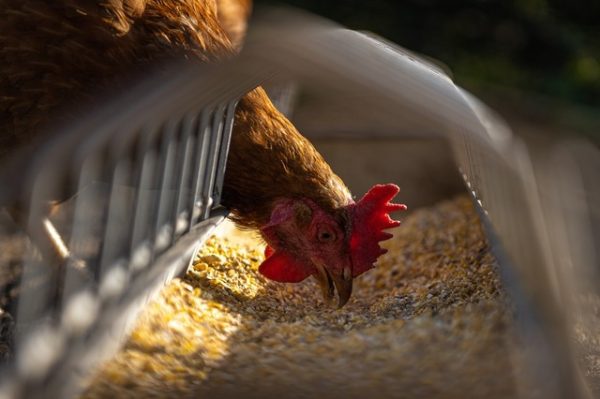
Treadle feeders are ideal to prevent wild birds and rodents from eating your chicken’s feed. They work by means of a paddle the chicken steps on to open it. So, you will need to teach your chickens how to use it!
Provide separate grit feeders filled with both types of chicken grit to aid in digestion and provide calcium.
Chicken Nesting Boxes
Every hen needs a comfortable and private space to lay her eggs.
Provide one nesting box for every 3-4 hens. Choose nesting boxes that are spacious enough for your breed of chicken and fill them with soft, clean bedding like straw or pine shavings. Place them in a quiet area of the coop with dim lighting to encourage use.
If you have questions, read my FAQ about chicken nesting boxes. If you are thinking about purchasing a chicken nesting box, read my review on the Top 10 Chicken Nesting Boxes.

Perches and Roosting Bars
Chickens instinctively roost at night, so your coop needs sturdy perches where they can comfortably sleep.
They prefer wide, flat perches over narrow, rounded ones. Wider perches allow them to spread their toes more naturally, reducing strain on their feet. Also, they provide a better grip and warmth in cold weather. On a wider perch, chickens can sit with their toes fully covered by their feathers, helping them stay warm on chilly nights.
Ideal dimensions are perches of at least 4 inches (10 cm) wide. A flat edge, like a 2×4 piece of lumber laid flat, is a great option. Chickens can use rounded perches, but a slightly flattened surface is more comfortable and natural for their feet.
Position perches at different heights to accommodate the pecking order, but at least 18 inches (45 cm) above the ground.
Pop Holes or Automatic Chicken Coop Doors
The pop hole is the chicken’s entry and exit point to the coop. It can be a simple opening with a door, or a more sophisticated automatic chicken coop door that opens and closes at dawn and dusk.
Whether you are a beginner or an experienced chicken keeper, in my opinion an automatic chicken coop door is a must, no matter what coop you have. So, what exactly is an automatic chicken coop door? It is a motorized coop door system that automatically opens in the morning and closes at night. Most models use timers, light sensors, or app-based controls to manage door movement. Some even include battery backups or solar panels for off-grid reliability.
Automatic chicken coop doors offer convenience and security, especially if you’re not always around to let your chickens in and out.
If you want to know more, read my review and FAQ on the Best Automatic Chicken Coop Doors.
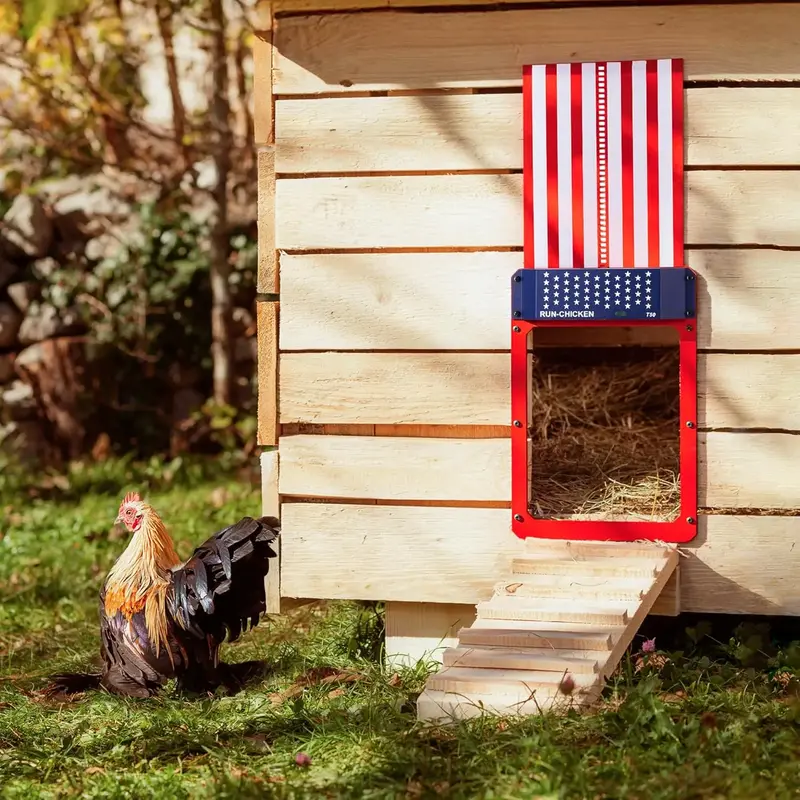
Optional Add-Ons for Efficiency
- Heated Perch: In colder climates, a heated perch can provide extra warmth and comfort for your chickens during the winter months.
- Watering System: Upgrade your chickens’ hydration station with a nipple watering system. This type of system provides a continuous supply of fresh, clean water while minimizing spills and messes.
- Solar-Powered Lighting: Add supplemental lighting to your coop with solar-powered lights. This can help extend the laying season during the shorter days of winter.
- Electric Fencing: If you have a free-range flock or live in an area with persistent predators,this can add an extra layer of protection. It can also be used to create temporary enclosures or to divide your run into different sections.
Keeping Your Chickens Entertained
Just like us, chickens can get bored, which can lead to unwanted behaviors like feather pecking, aggression, and even egg-eating.
That’s why it’s important to create a stimulating and fun environment for your cluckers.

Inside the Coop
- Perch Variety: Allow chickens to express their natural roosting preferences by adding branches, wooden dowels, or even repurposed ladders. Position them at different heights and angles for added fun.
- Treat Dispensers: Keep your chickens mentally stimulated with treat dispensers that release treats when pecked or rolled. You can also hang a peck toy filled with herbs and treats.
- Chicken Swings: Chickens love to swing, and you can build one pretty easily! Hang it from the coop ceiling or attach it to a sturdy beam to encourage exercise.
Outside in the Run
- Dust Bath: Provide a spacious dust bath area filled with loose dirt or sand. Chickens love to roll around in dust baths to clean their feathers and deter parasites.
- Foraging Space: Scatter scratch grains, mealworms, or other treats in the run to encourage foraging behavior. You can also hide treats in piles of leaves, straw, or wood chips.
- Gardening with Chickens: Allow your chickens supervised access to a designated garden area. They’ll love scratching and pecking for bugs and weeds, and you’ll get some help with pest control.
Rookie Mistakes To Watch Out For
Underestimating Size
It’s easy to get excited about a cute, compact coop. But chickens need space to cluck around and flap their wings. Always overestimate the amount of space your flock needs. Bigger is always better. The more room they have to roam, roost, and nest, the happier and healthier they’ll be.
Overlooking Local Regulation
Before you even start building or buying, check out local regulations or guidelines. These often dictate coop size, placement, and even the number of chickens allowed. Ignoring these could lead to fines or even forced relocation of your coop.
Falling For Trends
Remember, not all Pinterest ideas are practical. Don’t get swayed by fancy features or trendy designs that might not be practical or beneficial for your chickens. A functional coop will keep your flock happy and productive, even if it’s not the most Instagrammable.
Forgetting About Yourself
A coop that’s inconvenient for you to use and maintain can quickly turn chicken-keeping into a chore rather than a joy. Prioritize features that make cleaning, egg-collecting, and chicken care easy for years of happy chicken-keeping.
Not Planning for the Future
Take a moment to consider your long-term goals. If you plan to grow your flock, choose a coop that can be easily expanded with add-on modules or extensions. Also, think about potential changes in your space or climate. Use materials that can withstand weather shifts and allow flexibility for future adjustments.
Final Thoughts
Choosing the right chicken coop is a big decision. Just remember, the perfect coop is more than just walls and a roof. It’s a place where your chickens can feel safe, comfortable, and yes, a little spoiled.
So take a breath, consider their needs, and make it a space that works for both you and your flock. After all, happy hens lay happy eggs, and who doesn’t want that?
